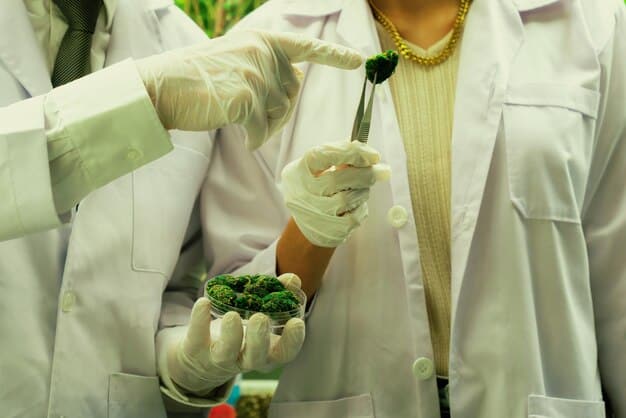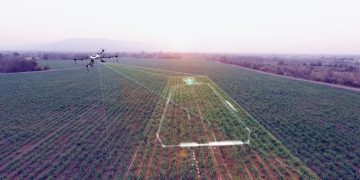Understanding GMOs: Safety, Benefits, and Risks Explored

Advertisements
Genetically Modified Organisms (GMOs) involve precise scientific techniques to alter an organism’s DNA, fundamentally aiming to enhance specific traits, with ongoing rigorous assessment regarding their safety, benefits in areas like crop yield and nutrition, and potential ecological and health risks that warrant continuous scientific scrutiny.
Advertisements
In our modern world, where food production is a complex tapestry woven with scientific advancements and strong public opinions, the concept of Understanding the Science of GMOs: Are They Safe and What are the Potential Benefits and Risks? often sparks vigorous debate. Beyond the headlines and emotionally charged arguments, a deeper dive into the science behind these modified organisms reveals a nuanced landscape of innovation, promise, and legitimate concerns.
The Fundamentals of Genetic Modification: What Exactly Are GMOs?
The term Genetically Modified Organism, or GMO, frequently appears in discussions about food and agriculture, yet its precise meaning can sometimes be obscured by misinformation. At its core, genetic modification involves the application of biotechnology to alter the genetic makeup of an organism, be it a plant, animal, or microorganism. Unlike traditional breeding, which relies on selecting and crossing organisms with desirable traits over many generations, genetic engineering allows for the direct insertion, deletion, or modification of specific genes with pinpoint accuracy.
Advertisements
This scientific precision means that traits that would take decades or even centuries to achieve through conventional methods can be introduced much more rapidly. For instance, a gene from a bacterium that confers pest resistance can be inserted directly into a plant, enabling it to produce its own internal defense against specific insects. This targeted approach seeks to imbue organisms with new or enhanced characteristics that benefit agriculture, medicine, or industry.
Distinguishing GMOs from Traditional Breeding
While both traditional breeding and genetic modification aim to improve organisms, their methodologies and capabilities differ significantly. Traditional breeding involves sexual reproduction or cross-pollination to mix entire genomes, hoping to combine desirable traits from two parents. This process is often imprecise, slow, and limited to traits naturally found within sexually compatible species.
Conversely, genetic engineering can transcend species barriers, allowing genes from vastly different organisms to be combined. For example, the creation of “golden rice,” which produces beta-carotene (a precursor to Vitamin A), involved incorporating genes from daffodil and a bacterium into rice. Such interventions are impossible through conventional breeding and highlight the unique potential of genetic modification.
- Specificity: Genetic engineering targets specific genes, ensuring more predictable outcomes.
- Speed: Desirable traits can be introduced much faster than through traditional breeding.
- Scope: Genes can be transferred between unrelated species, expanding the range of possible traits.
- Control: Scientists have precise control over the genetic changes introduced, minimizing unintended alterations.
Common Types of GMOs and Their Purposes
The vast majority of genetically modified crops currently grown are designed to address two primary agricultural challenges: pest control and herbicide tolerance. Insect-resistant crops, often containing genes from the bacterium Bacillus thuringiensis (Bt), produce proteins that are toxic to specific insect pests, reducing the need for chemical insecticides. Herbicide-tolerant crops, on the other hand, are engineered to withstand broad-spectrum herbicides, allowing farmers to control weeds more effectively without harming their crops.
Beyond these widespread applications, research is exploring a range of other beneficial traits. Drought-tolerant crops could thrive in arid regions, enhancing food security in challenging climates. Crops with enhanced nutritional profiles, such as those with increased vitamin content or healthier fatty acid compositions, aim to address dietary deficiencies. The scientific underpinnings of GMOs lie in their ability to precisely engineer specific traits into organisms, offering tailored solutions to complex agricultural and societal challenges. This foundational understanding is crucial for any informed discussion regarding their safety, benefits, and risks.
Are GMOs Safe to Eat? Examining the Scientific Consensus
The question of whether GMOs are safe for human consumption is perhaps the most contentious aspect of the debate, often fueled by public skepticism and misinformation. However, a significant body of scientific evidence and regulatory assessments worldwide consistently concludes that currently approved GMOs are as safe as their conventionally bred counterparts. This consensus is not merely an opinion but the culmination of decades of research, rigorous testing, and oversight by leading scientific and regulatory bodies globally.
Regulatory Frameworks and Approval Processes
Before any GMO crop can enter the food supply, it undergoes an extensive and multi-stage regulatory review process. In the United States, multiple agencies are involved, each with distinct responsibilities. The Food and Drug Administration (FDA) assesses the safety of GMO foods for human and animal consumption, typically through voluntary consultations with developers. The U.S. Department of Agriculture (USDA) oversees the environmental impact and safety of genetically engineered plants in agricultural production, ensuring they pose no plant pest risk. The Environmental Protection Agency (EPA) regulates GMOs that produce substances with pesticidal properties, such as Bt crops, to ensure their safe use and environmental impact.
Similar stringent regulatory frameworks exist in other developed nations, including the European Union, Canada, Australia, and Japan. While the specifics of these processes may vary, they generally involve:
- Molecular Characterization: Detailed analysis of the inserted DNA and its stability.
- Compositional Analysis: Comparison of nutrient levels, allergens, and toxins between GMO and conventional crops.
- Toxicology Studies: Assessment of potential adverse health effects in animal models.
- Allergenicity Assessment: Screening for new or increased allergenic potential.
- Environmental Risk Assessment: Evaluation of potential impacts on biodiversity, non-target organisms, and gene flow.
This multi-layered approach ensures that only GMOs demonstrating a strong safety profile are permitted for commercial use. The sheer volume and consistency of these regulatory approvals globally underscores the extensive scientific scrutiny these products undergo.
Concerns and Rebuttals: A Closer Look at Common Criticisms
Despite the scientific consensus on safety, several concerns frequently surface in public discourse. One common worry is the potential for GMOs to introduce new allergens or toxins into the food supply. Scientific studies and regulatory assessments specifically address this by performing thorough compositional analyses and allergenicity screenings. No commercially available GMO has been found to cause new allergic reactions or toxicity.
Another concern revolves around the possibility of horizontal gene transfer—the transfer of genetic material from GMOs to gut bacteria. While theoretical, extensive research has shown this to be highly improbable and, even if it occurred, unlikely to cause adverse health effects given the nature of the introduced genes.
Finally, the long-term health effects are often questioned. Given that the first GM crops were commercialized in the mid-1990s, there have now been over two decades of consumption. Major scientific bodies, including the National Academies of Sciences, Engineering, and Medicine (NASEM) and the World Health Organization (WHO), have conducted comprehensive reviews of existing research and found no evidence of adverse health effects attributable to the consumption of approved GMOs. While ongoing monitoring and research are always warranted, the weight of evidence points towards their safety. The scientific community emphasizes that each GMO trait and crop is assessed individually, ensuring a robust and evidence-based approach to safety assessment.
Potential Benefits of Genetically Modified Organisms
Beyond the contentious debates surrounding safety, a dispassionate look at GMOs reveals a range of significant benefits, particularly in the realm of agriculture and global food security. These benefits extend from enhanced crop resilience and yield to improved nutritional content and more sustainable farming practices, addressing some of the most pressing challenges facing humanity today.
Enhanced Crop Yield and Pest Resistance
One of the most celebrated achievements of GMOs is their ability to increase crop yields and reduce losses to pests. Insect-resistant crops, such as Bt corn and cotton, have significantly reduced the need for broad-spectrum insecticide sprays. This not only protects crops from devastating insect damage but also leads to higher productivity per acre, contributing to a more stable and abundant food supply.
Reduced pest damage translates directly into less crop loss, allowing farmers to harvest more from the same amount of land. This efficiency is critical as the global population continues to grow, placing increasing demands on agricultural systems. Furthermore, by making plants inherently resistant to certain pests, GMOs simplify farming practices for many growers, especially those in developing nations where access to costly chemical treatments may be limited.
Improved Nutritional Content and Food Security
While less prevalent than pest and herbicide resistance traits, the development of GMOs with enhanced nutritional profiles holds immense promise for global health. The most well-known example is “golden rice,” engineered to produce beta-carotene, a precursor to Vitamin A. Vitamin A deficiency is a major public health problem in many developing countries, leading to blindness and increased susceptibility to disease. Golden rice offers a potential dietary intervention to combat this deficiency in populations reliant on rice as a staple food.
Beyond golden rice, research is underway to develop crops with increased iron content to combat anemia, enhanced healthy fatty acids in oils, and improved protein quality. These advancements could play a crucial role in alleviating malnutrition and improving the overall health of vulnerable populations, particularly in regions where access to diverse and nutrient-rich diets is limited. Such innovations represent a direct application of biotechnology to address humanitarian challenges.

Environmental Advantages and Sustainable Agriculture
The environmental impacts of agriculture are a growing concern, and GMOs offer several pathways to more sustainable farming practices. By reducing the need for insecticide applications, particularly in Bt crops, GMOs lessen the chemical load on the environment, protecting beneficial insects like pollinators and reducing runoff into water systems.
Furthermore, herbicide-tolerant crops often facilitate “no-till” or “reduced-till” farming practices. Traditional tillage involves plowing the soil, which can lead to erosion, loss of soil organic matter, and increased greenhouse gas emissions. With herbicide-tolerant crops, farmers can control weeds without disturbing the soil, thus conserving soil moisture, improving soil health, and reducing carbon emissions from agricultural machinery.
- Reduced Pesticide Use: Lower reliance on chemical sprays for pest control.
- Soil Conservation: Facilitates no-till farming, reducing erosion and improving soil structure.
- Lower Carbon Footprint: Less fuel consumption from reduced tillage and fewer pesticide applications.
- Efficient Land Use: Higher yields from existing land, reducing pressure for agricultural expansion into natural habitats.
These environmental benefits contribute to a more sustainable agricultural system, aligning with broader goals for ecological protection and resource conservation. The potential of GMOs to offer solutions to global food scarcity, nutritional deficiencies, and environmental challenges highlights their profound significance in the ongoing effort to feed a growing planet responsibly.
Potential Risks and Ongoing Debates
While the scientific consensus largely affirms the safety of approved GMOs for consumption, the discussion surrounding their potential risks extends beyond human health to encompass environmental, economic, and social dimensions. These concerns, some validated by research and others remaining theoretical, form the basis of ongoing debates and call for continuous vigilance and careful management.
Environmental Concerns: Gene Flow and Biodiversity
One of the most frequently raised environmental concerns is the potential for gene flow from GM crops to wild relatives or conventional crops. This “escape” of engineered genes could theoretically lead to the transfer of herbicide tolerance or pest resistance to weeds, creating “superweeds” that are harder to control. While cases of gene flow have been documented, the emergence of superweeds is more often attributed to over-reliance on a single herbicide or farming practice, rather than the intrinsic nature of the GM trait itself. Effective stewardship practices, such as crop rotation and diversification of weed control methods, are crucial to mitigate this risk.
Another concern relates to the impact on biodiversity, particularly non-target organisms. For example, debates have occurred regarding the potential effects of Bt crops on non-pest insects, such as monarch butterflies. Research has generally shown that while high concentrations of Bt pollen can harm monarch larvae, real-world field conditions typically pose a negligible risk. However, ongoing monitoring and research are essential to identify and mitigate any unforeseen ecological consequences, especially as new traits are developed. The scientific community approaches these issues with a commitment to evidence-based assessment and adaptive management strategies.
Economic and Social Implications
The economic implications of GMOs are complex and multifaceted. For many small-scale farmers, the intellectual property rights associated with patented GM seeds can be a significant barrier. Farmers are generally required to purchase new seeds each year, as saving seeds for replanting, a traditional practice, is prohibited for patented varieties. This can increase input costs and raise concerns about dependency on a few large biotechnology companies. This economic structure has led to calls for alternative models that ensure equitable access and benefit-sharing, particularly for farmers in developing countries.
Socially, the debate over GMOs reflects broader tensions about who controls the food supply and the role of corporate science in agriculture. Concerns about the industrialization of farming, the erosion of traditional farming practices, and the potential for increased inequality in food production are often intertwined with discussions about GMOs. Transparency, public engagement, and diverse stakeholder representation are crucial for addressing these socio-economic dimensions.
Precautionary Principle and the Need for Continued Research
The precautionary principle, which suggests that if an action or policy has a suspected risk of causing harm to the public or to the environment, in the absence of scientific consensus that the action or policy is harmful, the burden of proof that it is not harmful falls on those taking the action, is often invoked in debates about GMOs. Proponents of this principle argue for a more cautious approach to new GM technologies until their long-term effects are fully understood.
While the scientific consensus affirms the safety of currently approved GM crops, the dynamic nature of genetic engineering means that continued, independent, and transparent research is always necessary. This includes:
- Long-term Environmental Monitoring: Tracking ecological impacts over decades.
- Post-Market Surveillance: Monitoring health outcomes in populations consuming GMOs.
- Research on New GM Technologies: Thorough evaluation of emerging techniques like gene editing.
- Socio-Economic Impact Studies: Assessing the broader effects on farming communities and food systems.
This proactive research ensures that regulatory frameworks can adapt to new scientific insights and that potential risks are identified and addressed early. The ongoing dialogue surrounding GMOs highlights the importance of balancing innovation with thoughtful risk assessment, driven by robust science and public interest.
The Future of GMOs: Gene Editing and Beyond
As biotechnology rapidly advances, the landscape of genetic modification is evolving far beyond the initial methods used to create “first-generation” GMOs. Gene editing technologies, particularly CRISPR-Cas9, are transformative, offering unprecedented precision and opening new frontiers for manipulating the genetic code. Understanding these emerging technologies is crucial for appreciating the future trajectory of agricultural innovation and its implications.
The Rise of Gene Editing (CRISPR-Cas9)
Traditional genetic modification often involves inserting foreign DNA into an organism, which can be somewhat imprecise, leading to concerns about off-target effects. Gene editing, by contrast, acts like a molecular “scissors,” allowing scientists to make precise cuts and edits to an organism’s existing DNA. CRISPR-Cas9 is the most widely adopted and celebrated of these tools, enabling scientists to:
- Knock out specific genes: Inactivate genes that produce undesirable traits.
- Insert new genetic material with precision: Place new genes exactly where intended.
- Change single base pairs: Correct subtle genetic “typos” that cause disease or limit desirable traits.
This precision dramatically reduces the chances of unintended genetic changes and eliminates the need to introduce foreign DNA from other species in many applications. For example, CRISPR has been used to create non-browning mushrooms by knocking out a specific browning gene, or to develop disease-resistant crops by subtly altering existing genes. Because gene editing can result in changes that are indistinguishable from natural mutations or conventional breeding, regulatory discussions are ongoing about how these “genome-edited” products should be regulated. Many argue they should be treated differently from traditional GMOs due to their precise nature and lack of foreign DNA.
Applications Beyond Traditional Agriculture
The scope of gene editing extends far beyond the agricultural applications of first-generation GMOs. In medicine, CRISPR is revolutionizing gene therapy, offering potential cures for genetic diseases like sickle cell anemia, cystic fibrosis, and even certain cancers. Researchers are also exploring its use to develop disease-resistant livestock, reducing the need for antibiotics in animal agriculture.
In industrial biotechnology, gene editing might be used to engineer microorganisms for more efficient biofuel production, biodegradable plastics, or novel pharmaceuticals. The ability to precisely tweak the genetic machinery of organisms opens vast possibilities across various sectors, promising solutions to challenges in health, environment, and manufacturing. This broad applicability highlights the revolutionary potential of gene editing as a fundamental scientific tool.
Ethical Considerations and Societal Discussions
As gene editing technologies become more powerful and accessible, they inevitably bring forth profound ethical and societal considerations. Debates often focus on:
- “Designer Babies”: The hypothetical use of gene editing in human embryos to select for desired traits, raising significant moral and ethical dilemmas.
- Ecological Disruptions: The potential for edited organisms, if released into the wild, to have unforeseen ecological impacts, even if the edits are subtle.
- Accessibility and Equity: Ensuring that the benefits of these technologies are accessible globally and do not exacerbate existing inequalities.
- Public Perception and Trust: The ongoing challenge of communicating the science accurately and building public trust, particularly given historical controversies surrounding GMOs.
Navigating these complex ethical landscapes requires open, inclusive, and informed societal discussions. Science alone cannot dictate ethical boundaries; rather, it provides the possibilities, while society must collectively decide how and where to apply these powerful tools responsibly. The future of GMOs, driven by advancements in gene editing, promises significant breakthroughs but also demands careful consideration of their broader implications for humanity and the planet.
Global Perspectives: GMO Adoption and Public Acceptance
The adoption and acceptance of Genetically Modified Organisms vary significantly across different regions of the world, reflecting a complex interplay of scientific assessment, regulatory frameworks, economic interests, cultural values, and public perception. Understanding these diverse global perspectives is key to grasping the full scope of the GMO debate.
Varying Regulatory Stances by Continent
North America, particularly the United States and Canada, has been at the forefront of GMO adoption. Their regulatory systems tend to be product-focused, meaning they evaluate the final product (the GM crop) rather than the process used to create it. This approach, alongside generally pro-innovation policies, has led to widespread cultivation of GM corn, soybeans, cotton, and canola.
In contrast, the European Union (EU) has adopted a much more cautious, process-based approach to GMO regulation, viewing the genetic engineering process itself as requiring stringent scrutiny. This has resulted in a much slower approval process, a limited number of commercially cultivated GM crops, and strong labeling requirements for GM ingredients. Public opposition in many EU countries has also been a significant factor.
Asia presents a mixed picture. Countries like China, India, and the Philippines are increasingly adopting GM crops like cotton and rice, driven by food security concerns and agricultural productivity goals. Others, like South Korea and Japan, have stringent import regulations and limited domestic cultivation, reflecting a more cautious stance similar to parts of Europe. African nations also show varied approaches, with some countries like South Africa embracing GM crops (especially corn), while others remain hesitant due to concerns over trade, intellectual property, and seed sovereignty. These diverse regulatory postures highlight the lack of a universal legal or scientific consensus on how to best manage and introduce these technologies.
Factors Influencing Public Perception
Public acceptance of GMOs is a complex phenomenon influenced by a myriad of factors, often distinct from scientific consensus. One major factor is the perceived benefit versus risk. Where clear benefits are demonstrated (e.g., in medical applications), acceptance tends to be higher. In food, perceived benefits (like higher yields for farmers) are often weighed against perceived risks (like unknown health effects).
Trust in regulatory bodies, scientific institutions, and food companies also plays a crucial role. In regions where trust is high, public acceptance is generally higher. Conversely, historical food scandals or a lack of transparency can erode trust and foster skepticism. The framing of information by media, advocacy groups, and social networks significantly shapes public opinion. Sensationalized reporting or emotionally charged narratives can quickly overshadow scientific evidence.
Furthermore, cultural values, environmental concerns, and socio-economic contexts all contribute. For instance, in cultures that prioritize traditional farming methods or view “natural” food as inherently superior, GM products may face greater resistance. Economic concerns, such as the perceived control of seed supply by multinational corporations, also fuel opposition in many communities.
The Role of Labeling and Consumer Choice
The debate over GMO labeling underscores the divergence in global public and regulatory perspectives. In the US, mandatory labeling for GM foods was implemented in 2022, providing consumers with information about bioengineered ingredients. Similarly, countries in the EU, Australia, and Brazil have had mandatory labeling for many years, often resulting in lower consumer uptake of GM products, even when they are present on shelves.
Advocates for labeling argue that consumers have a right to know what is in their food and to make informed choices based on their values, whether those values are driven by health, environmental concerns, or ethical considerations. They contend that lack of labeling can breed mistrust and perceived corporate secrecy. Opponents of mandatory labeling argue that it implies a safety warning where none is scientifically warranted and can confuse consumers, leading to unnecessary avoidance of safe and beneficial foods. They also point to potential economic costs for producers and retailers.
Ultimately, consumer choice and transparency are increasingly at the forefront of discussions. As technologies evolve and global food systems become more interconnected, fostering informed public dialogue, alongside sound scientific assessment and transparent regulatory practices, will be crucial for navigating the diverse global landscape of GMO adoption and acceptance. The varied approaches worldwide underscore that the discussion is not purely scientific, but also deeply embedded in societal values and policy choices.
| Key Point | Brief Description |
|---|---|
| 🔬 What are GMOs? | Organisms with altered DNA for specific traits, using precise biotech techniques. |
| ✔️ Are They Safe? | Scientific consensus and regulatory bodies affirm safety for approved GMOs. |
| 🌱 Benefits | Increased yield, pest resistance, nutritional enhancement, and sustainable farming. |
| ⚠️ Risks & Debates | Concerns about gene flow, biodiversity impact, economic control, and public perception. |
Frequently Asked Questions About GMOs
▼
GMO stands for Genetically Modified Organism. It refers to a plant, animal, or microorganism whose genetic material (DNA) has been altered in a way that does not occur naturally by mating and/or natural recombination. This often involves introducing specific genes from another organism to confer new traits, like pest resistance or enhanced nutrition.
▼
Yes, the vast majority of scientific organizations and regulatory authorities worldwide, including the U.S. Food and Drug Administration (FDA) and the World Health Organization (WHO), conclude that approved GMOs are safe to eat and pose no greater risk than conventional foods. This consensus is based on decades of research and rigorous testing.
▼
Key benefits of GMO crops include increased crop yields through reduced pest damage and enhanced herbicide tolerance, which simplifies weed control. Some GMOs also offer improved nutritional content (e.g., Golden Rice), better resistance to diseases and drought, and can contribute to more sustainable farming practices like reduced tillage.
▼
Concerns about GMOs often include potential environmental impacts such as gene flow to wild relatives, impacts on biodiversity, and the development of herbicide-resistant weeds. Economic factors like seed patenting and corporate control over agriculture, as well as debates over adequate long-term research and public perception, are also frequently discussed.
▼
Gene editing, such as CRISPR-Cas9, allows for much more precise changes to an organism’s existing DNA, often without introducing foreign genetic material. Traditional genetic modification typically involves inserting genes from other species, which can be less precise. Gene editing can create changes indistinguishable from natural mutations, sparking debates on their regulation.

Conclusion
The journey to Understanding the Science of GMOs: Are They Safe and What are the Potential Benefits and Risks? reveals a scientific field that is both complex and profoundly impactful. While the scientific consensus firmly establishes the safety of approved genetically modified organisms for consumption, the broader narrative is one of balancing innovation with careful oversight. GMOs offer significant advantages, from bolstering food security through enhanced yields and nutritional value to promoting more sustainable agricultural practices. Yet, alongside these benefits, there remain valid concerns regarding environmental interactions, economic implications, and the continuous need for rigorous, transparent research. As gene editing technologies usher in a new era of even greater precision, the conversation around GMOs will continue to evolve, requiring informed public discourse, adaptive regulatory frameworks, and an unwavering commitment to evidence-based decision-making to harness their full potential responsibly.





